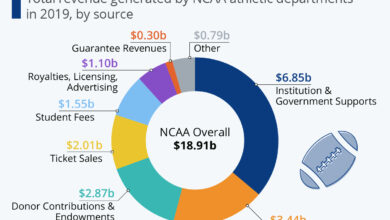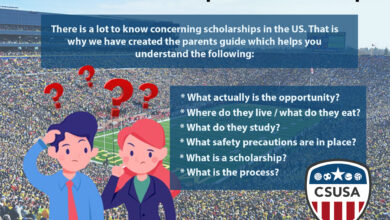Athletic Scholarships For College Students: Maximizing Opportunities For Student-Athletes
Athletic scholarships for college students pave the way for academic and athletic success. From understanding eligibility criteria to navigating the application process, these scholarships offer a unique opportunity for student-athletes to excel both on and off the field.
Overview of Athletic Scholarships
Athletic scholarships are financial aids given to student-athletes based on their athletic abilities in sports, unlike academic scholarships which are awarded for academic achievements. These scholarships are common in sports such as basketball, football, soccer, track and field, and volleyball, among others.
Benefits of Athletic Scholarships
- Athletic scholarships help student-athletes cover the cost of tuition, room and board, and other expenses associated with attending college.
- They provide opportunities for student-athletes to continue playing sports at a competitive level while pursuing their education.
- Athletic scholarships can open doors for student-athletes to join top collegiate sports programs and potentially compete at a professional level in the future.
Qualifying Criteria for Athletic Scholarships
- Student-athletes must demonstrate exceptional athletic abilities in their respective sports.
- They need to maintain good academic standing to meet the eligibility requirements set by the NCAA or NAIA.
- Student-athletes must adhere to the rules and regulations of the sports governing bodies to qualify for athletic scholarships.
Application Process and Requirements
- Student-athletes typically need to create an online profile on recruiting websites and reach out to college coaches to express their interest.
- They may be required to provide academic transcripts, letters of recommendation, sports highlight videos, and standardized test scores as part of their application.
- Student-athletes need to register with the NCAA Eligibility Center and complete the necessary paperwork to be considered for athletic scholarships.
Eligibility for Division I, II, and III Scholarships
- Division I scholarships are highly competitive and require student-athletes to meet specific academic and athletic standards.
- Division II scholarships are offered to student-athletes with slightly lower academic and athletic qualifications than Division I.
- Division III schools do not offer athletic scholarships but may provide other forms of financial aid based on need or merit.
Standing Out in Athletic Scholarship Applications
- Student-athletes can stand out by maintaining a strong academic record, actively reaching out to college coaches, attending showcase events, and showcasing their skills through highlight videos.
- Networking with current college athletes and seeking mentorship can also help student-athletes make a positive impression during the application process.
Implications of Accepting Athletic Scholarships
- Accepting an athletic scholarship requires student-athletes to balance their academic and athletic responsibilities effectively.
- Student-athletes need to meet the academic requirements set by their college or university to retain their scholarships and continue competing in their sports.
- There may be pressure to perform well both academically and athletically, but the support and resources provided through athletic scholarships can help student-athletes succeed.
Eligibility Criteria
To secure an athletic scholarship, student-athletes must meet specific eligibility requirements that go beyond just their athletic abilities. These criteria typically include maintaining a certain academic standard, showcasing exceptional sports skills, and demonstrating good character both on and off the field.
Academic Standards
Student-athletes aiming for athletic scholarships must meet the academic standards set by the NCAA, NAIA, or other governing bodies. This often involves maintaining a minimum GPA, completing a required number of core courses, and achieving a certain score on standardized tests like the SAT or ACT.
- Minimum GPA requirement set by the institution or athletic association.
- Completion of a specific number of core courses in subjects like English, Math, and Science.
- Achievement of a minimum score on standardized tests like the SAT or ACT.
Extracurricular Activities
Engaging in extracurricular activities beyond sports can significantly enhance a student’s eligibility for athletic scholarships. This involvement showcases a well-rounded personality, leadership skills, and a commitment to community service.
- Participation in clubs or organizations related to academics, arts, or community service.
- Leadership roles in school clubs, teams, or community projects.
- Volunteer work or community service activities outside of school.
Application Process
When it comes to applying for athletic scholarships, there are several key steps to keep in mind. From maintaining communication with coaches to creating a standout application, each stage is crucial in securing the scholarship you desire.
Maintaining Communication with Coaches
- Regularly update coaches on your progress, achievements, and any upcoming competitions.
- Ask for feedback on your performance and areas for improvement to show your dedication.
- Express gratitude for their support and guidance throughout the application process.
Creating a Standout Application
- Highlight your athletic achievements, academic success, and leadership skills in your application.
- Craft a compelling personal statement that showcases your passion for your sport and your goals for the future.
- Include any relevant volunteer work, extracurricular activities, or community involvement to demonstrate your well-roundedness.
Researching Potential Scholarships
- Research online databases, university websites, and athletic associations to identify scholarships that align with your sport and academic profile.
- Consider reaching out to alumni or current scholarship recipients for insights into the application process.
- Attend college fairs or information sessions to learn more about available scholarships and programs.
Reaching Out to Coaches
- Craft personalized emails or letters expressing your interest in the program and detailing your athletic achievements.
- Attach your athletic resume, including statistics, awards, and experiences that showcase your skills.
- Follow up with coaches after sending your application to reaffirm your interest and provide any additional information they may require.
Obtaining Strong Letters of Recommendation
- Request letters of recommendation from coaches, teachers, or mentors who can speak to your character, work ethic, and potential as a student-athlete.
- Provide them with relevant information about the scholarship and why you are a strong candidate to help them craft compelling letters.
- Follow up with a thank you note to show your appreciation for their support.
Meeting Application Deadlines
- Keep track of all application deadlines and ensure you submit all required documents, including academic transcripts and test scores, on time.
- Double-check your application for completeness and accuracy before submitting to avoid any delays or missing information.
- Reach out to the scholarship committee if you have any questions or concerns about the application process.
Preparing for Interviews with Coaches
- Practice discussing your athletic achievements, academic goals, and reasons for choosing their program to showcase your dedication and passion.
- Research the college and athletic program thoroughly to ask informed questions and demonstrate your interest in joining their team.
- Dress professionally and arrive on time for interviews to make a positive impression on the coaching staff.
Types of Athletic Scholarships
When it comes to athletic scholarships, there are various types available to student-athletes. Understanding the differences between full-ride scholarships, partial scholarships, and NCAA Division I, II, and III scholarships can help athletes navigate their options effectively.
Full-Ride Scholarships vs. Partial Scholarships
Full-ride scholarships cover the entire cost of attending college, including tuition, room and board, books, and other expenses. These scholarships are highly competitive and are usually offered to top-tier athletes. On the other hand, partial scholarships cover only a portion of the expenses, requiring students to cover the remaining costs themselves. While partial scholarships may not cover everything, they still provide valuable financial assistance to student-athletes.
NCAA Division I, II, and III Scholarships
The NCAA (National Collegiate Athletic Association) oversees college athletics and offers scholarships at three different divisions. Division I schools typically offer the most competitive athletic programs and scholarships. Division II schools also offer athletic scholarships but at a lower level of competition. Division III schools do not offer athletic scholarships based on athletic ability, but they do provide other forms of financial aid.
Walk-On Opportunities
In addition to scholarship opportunities, student-athletes can also pursue walk-on opportunities. Walk-on athletes are not initially awarded scholarships but have the chance to earn a spot on the team through tryouts or by proving their skills and dedication to the coach. While walk-ons do not receive athletic scholarships at the beginning, they may be eligible for scholarships in the future based on their performance and contributions to the team.
Responsibilities of Recipients
Upon accepting an athletic scholarship, recipients must understand the obligations and responsibilities that come with this opportunity. It is crucial for student-athletes to maintain a balance between their academic pursuits and athletic commitments to ensure success both on and off the field.
Academic and Athletic Balance
Maintaining a high level of academic performance while excelling in sports is a key expectation for scholarship recipients. Student-athletes must prioritize their studies and meet the academic requirements set by their institution to remain eligible for their scholarship. Balancing a demanding training schedule with coursework can be challenging, but it is essential for long-term success.
- Attend all classes regularly and complete assignments on time.
- Communicate with professors and coaches regarding scheduling conflicts.
- Utilize academic support services provided by the university to stay on track.
- Develop time management skills to effectively juggle academic and athletic responsibilities.
Expectations for Student-Athletes
Recipients of athletic scholarships are expected to represent their school with integrity both on and off the field. They serve as ambassadors for their institution and are held to high standards of conduct and sportsmanship. Additionally, student-athletes may be required to participate in community service activities and maintain a positive public image.
Student-athletes should demonstrate leadership, discipline, and teamwork in all aspects of their college experience.
- Adhere to the rules and regulations set by the NCAA or respective athletic association.
- Participate in team meetings, practices, and competitions with dedication and enthusiasm.
- Engage in community outreach initiatives to give back to the local area.
- Act as role models for younger athletes and inspire others through their achievements.
Impact on College Experience
Receiving an athletic scholarship can significantly shape a student’s overall college experience by providing unique opportunities for personal growth and development. The role of athletics goes beyond just sports, as it fosters discipline, time management skills, and teamwork among scholarship recipients.
Personal Growth and Development
Athletic scholarships offer more than just financial assistance; they also provide access to specialized training facilities, mentorship from experienced coaches, and networking opportunities with professionals in the sports industry. This exposure can help students build confidence, leadership skills, and a strong work ethic that extends beyond the playing field.
Time Management and Discipline
Balancing academics and sports as a scholarship athlete requires excellent time management skills and discipline. By juggling rigorous training schedules, games, and academic responsibilities, students learn how to prioritize tasks, stay organized, and meet deadlines effectively. This experience not only enhances their college experience but also prepares them for future challenges in their careers.
Team Dynamics and Personal Growth
The camaraderie and team dynamics experienced by scholarship athletes play a vital role in shaping their college journey. The support and encouragement from teammates, coaches, and staff create a sense of community and belonging that enhances the overall college experience. These relationships often lead to lifelong friendships and valuable networking connections.
Comparison with Non-Scholarship Athletes
Student-athletes who receive scholarships often have access to better resources, facilities, and opportunities compared to their non-scholarship counterparts. This difference in support can impact their overall college experience, providing them with a competitive edge both on and off the field. The challenges and growth opportunities faced by scholarship athletes may differ from those of non-scholarship athletes, leading to unique experiences and outcomes.
Retaining Athletic Scholarships
Maintaining an athletic scholarship is crucial for student-athletes to continue their education without financial burden. Here are some key points to consider in order to retain athletic scholarships:
Academic Requirements
- Student-athletes are typically required to maintain a minimum GPA to retain their athletic scholarships. This GPA threshold varies depending on the institution and the specific scholarship.
- Attending all classes and completing coursework on time is essential for meeting academic requirements.
Common Mistakes
- Procrastination and poor time management can lead to missed assignments or exams, ultimately affecting GPA.
- Ignoring or underestimating the importance of academic performance in relation to their athletic commitments.
- Failure to seek help or support when facing academic challenges.
Communication Process
- Student-athletes should establish open communication with their coaches and academic advisors early on if they are struggling academically.
- Scheduling regular meetings to discuss academic progress and seek guidance on how to improve performance.
- Creating a proactive plan with the support of academic advisors to address any academic deficiencies promptly.
Consequences of Not Meeting Requirements
- Failure to maintain the required GPA or academic standing can result in the loss of the athletic scholarship.
- Being placed on academic probation or suspension, which can impact eligibility to compete in sports and continue receiving financial aid.
- Ultimately, not meeting scholarship requirements can jeopardize the student-athlete’s ability to afford college and continue participating in their sport.
Opportunities for Non-Division I Athletes
Student-athletes in non-Division I sports also have access to scholarship opportunities to support their academic and athletic pursuits. While Division I scholarships may be more competitive, there are alternative sources of financial aid available for athletes in lesser-known sports.
Scholarship Opportunities for Non-Division I Athletes
Non-Division I athletes can explore scholarship opportunities through various channels, including:
- Local community organizations
- Regional sports clubs
- Private foundations
Alternative Sources of Financial Aid
Student-athletes who may not qualify for Division I scholarships can still secure financial aid through:
- Academic scholarships
- Merit-based scholarships
- Need-based financial aid
Securing Scholarships for Lesser-Known Sports
Student-athletes participating in lesser-known sports can increase their chances of securing scholarships by:
- Networking with coaches and sports organizations
- Seeking out niche scholarship opportunities
- Demonstrating dedication and passion for their sport
Women’s Athletic Scholarships
Women’s athletic scholarships have become increasingly available for female athletes looking to pursue their passion for sports while furthering their education. These scholarships provide opportunities for talented female student-athletes to showcase their skills and compete at the collegiate level.
Growth of Women’s Sports Scholarships
In recent years, there has been a significant growth in women’s sports scholarships, offering more chances for female athletes to receive financial support for their athletic endeavors. Colleges and universities are recognizing the talent and dedication of female student-athletes and are providing more scholarship opportunities to support their athletic pursuits.
Success Stories of Female Student-Athletes
- One success story is that of Sarah, a talented soccer player who received a full athletic scholarship to play for her college team. This scholarship not only helped her financially but also allowed her to showcase her skills on a larger platform.
- Another inspiring story is that of Maya, a track and field athlete who earned an athletic scholarship that covered her tuition and training expenses. This support enabled her to excel in her sport while pursuing her academic goals.
Guidance for Female Student-Athletes
Female student-athletes looking to secure athletic scholarships should proactively research and apply for opportunities that align with their athletic abilities and academic interests. It is essential to reach out to college coaches, attend recruitment events, and showcase their skills through videos and athletic achievements.
Statistics on Female Athletes and Scholarships
According to recent data, approximately 43% of female athletes receive athletic scholarships, compared to 56% of male athletes. This highlights the importance of creating more opportunities for female student-athletes in the realm of sports scholarships.
Impact on Female Athletes
Athletic scholarships play a crucial role in the overall development and empowerment of female athletes in sports. These scholarships not only provide financial support but also boost confidence, leadership skills, and a sense of accomplishment among female student-athletes, contributing to their growth on and off the field.
Recruitment Process for Female Athletes
The recruitment process for female athletes differs from that of male athletes in the context of athletic scholarships. Female student-athletes may need to navigate unique challenges, such as breaking stereotypes, showcasing their skills in a male-dominated field, and finding programs that prioritize women’s sports. Coaches and recruiters are increasingly focusing on recruiting talented female athletes and providing them with the support they need to succeed.
Impact of COVID-19 on Athletic Scholarships
The COVID-19 pandemic has significantly impacted the landscape of athletic scholarships, leading to various changes in recruitment processes and scholarship availability. Student-athletes have had to navigate through uncertain times to secure scholarship opportunities, with different sports experiencing varying effects, such as football, basketball, and soccer. Virtual recruitment events have become essential in the current scholarship landscape, emphasizing the importance of maintaining academic performance alongside athletic achievements to secure scholarships. The long-term implications of the pandemic on athletic scholarship funding and availability are also being evaluated, prompting student-athletes to showcase their skills and stand out to recruiters in a primarily virtual recruitment environment.
Changes in Recruitment Processes and Scholarship Availability
The COVID-19 pandemic forced colleges and universities to adapt their recruitment processes to comply with safety regulations. In-person visits and showcases were replaced by virtual events, impacting the ability of student-athletes to showcase their skills effectively. This shift led to changes in scholarship availability, with some institutions reducing funding for athletic programs due to financial constraints caused by the pandemic.
Navigating Scholarship Opportunities during Uncertain Times
Student-athletes have had to proactively seek out scholarship opportunities amidst the uncertainties brought about by the pandemic. Utilizing online platforms, attending virtual showcases, and maintaining communication with coaches and recruiters have become crucial strategies for navigating scholarship opportunities in these challenging times.
Differential Impact on Scholarship Opportunities for Different Sports
Sports like football, basketball, and soccer, which typically receive higher visibility and funding, have experienced less severe impacts on scholarship availability compared to lesser-known sports. Student-athletes in niche sports may face greater challenges in securing scholarships due to decreased funding and resources allocated to their programs.
Role of Virtual Recruitment Events in the Scholarship Landscape
Virtual recruitment events have become a primary tool for connecting student-athletes with college coaches and recruiters. These events allow athletes to showcase their skills remotely, providing an opportunity to gain visibility and interest from potential scholarship providers in a safe and accessible manner.
Importance of Academic Performance for Securing Scholarships
Maintaining a balance between academic performance and athletic achievements is crucial for securing scholarships, especially in the current uncertain environment. Colleges and universities prioritize student-athletes who demonstrate excellence both on the field and in the classroom, emphasizing the importance of academic success alongside athletic prowess.
Long-Term Implications on Athletic Scholarship Funding and Availability
The long-term implications of the pandemic on athletic scholarship funding and availability remain uncertain. Some institutions may continue to face financial challenges, impacting their ability to provide scholarships to student-athletes. It is essential for student-athletes to stay informed about changes in scholarship programs and adapt their strategies accordingly.
Strategies for Showcasing Skills in a Virtual Recruitment Environment
To stand out to recruiters in a primarily virtual recruitment environment, student-athletes can leverage technology to create highlight videos, participate in virtual training sessions, and engage with coaches through online platforms. Building a strong online presence and actively seeking opportunities to demonstrate skills can enhance visibility and increase chances of securing athletic scholarships.
Balancing Athletics and Academics
Student-athletes often face the challenge of juggling their athletic commitments with academic responsibilities. Maintaining a balance between the two is crucial for success in both areas.
Strategies for Balancing Athletics and Academics
- Establish a routine: Create a schedule that allocates time for both training/practice and studying.
- Utilize time management tools: Use planners, calendars, or apps to stay organized and prioritize tasks.
- Communicate with professors: Keep your instructors informed about your athletic schedule to manage deadlines and exams effectively.
- Take advantage of study groups: Collaborate with teammates or classmates to enhance your learning experience.
Importance of Time Management and Prioritization
Time management is essential for scholarship recipients to excel in both athletics and academics. By prioritizing tasks and deadlines, student-athletes can ensure they meet their commitments and achieve success in all areas of their college experience.
Tips for Maintaining Academic Success
- Set realistic goals: Establish achievable academic targets while considering your athletic schedule.
- Stay organized: Keep track of assignments, exams, and training sessions to avoid last-minute cramming or conflicts.
- Seek support when needed: Don’t hesitate to ask for help from coaches, professors, or academic advisors to manage your workload effectively.
- Prioritize self-care: Maintain a healthy lifestyle with proper sleep, nutrition, and exercise to support your overall well-being.
Professional Development Through Athletics
Participation in college athletics can significantly contribute to a student’s professional development. Student-athletes acquire a range of transferable skills through their sports experiences that can benefit them in their future careers. Many successful professionals credit their athletic backgrounds for helping them achieve career success.
Transferable Skills Gained Through Sports
- Time management: Balancing academics and athletics teaches student-athletes how to effectively manage their time and prioritize tasks.
- Leadership: Captaining a team or taking on leadership roles in sports can help develop strong leadership skills that are valuable in the workplace.
- Teamwork: Collaboration and effective communication within a team environment translate to successful teamwork in professional settings.
- Resilience: Overcoming challenges and setbacks in sports fosters resilience, a crucial quality in navigating obstacles in one’s career.
Examples of Successful Professionals with Athletic Backgrounds
- Michael Jordan: The legendary basketball player’s work ethic and competitiveness on the court translated into a successful career as a business owner and entrepreneur.
- Venus Williams: The tennis champion’s dedication to her sport has shaped her into a successful businesswoman and advocate for equal pay in sports.
- Alex Morgan: The soccer star’s leadership skills on the field have contributed to her success as a role model for women in sports and beyond.
Alumni Support and Networking
Maintaining connections with alumni can be crucial for student-athletes even after graduation. Alumni networks play a significant role in supporting scholarship recipients as they transition into the professional world. Leveraging these connections can open up doors to valuable career opportunities and mentorship.
Importance of Alumni Relationships
Building and nurturing relationships with alumni can provide student-athletes with a strong support system beyond their college years. By staying connected with former scholarship recipients, student-athletes can access a wealth of knowledge, guidance, and potential job leads in their chosen field.
- Alumni may assist student-athletes in securing internships or job placements through referrals and personal recommendations.
- Networking with alumni can lead to valuable connections in the sports industry, offering insights and advice on career paths.
- Attending alumni events provides opportunities to interact with successful professionals who can offer guidance and support.
Utilizing Alumni Networks
To effectively tap into alumni support for career advancement, student-athletes can follow these steps:
- Research and identify alumni who are working in the sports industry or related fields.
- Reach out via professional networking platforms like LinkedIn to request informational interviews or mentorship.
- Attend alumni events or networking functions to establish personal connections and showcase skills and aspirations.
- Show appreciation for alumni support and maintain regular communication to nurture relationships.
- Offer to give back to the alumni network through mentorship programs or volunteering opportunities.
Conclusive Thoughts
In conclusion, Athletic scholarships for college students not only provide financial support but also shape a student’s college experience. By balancing academics and athletics, recipients can unlock a world of opportunities for personal growth and professional development.









